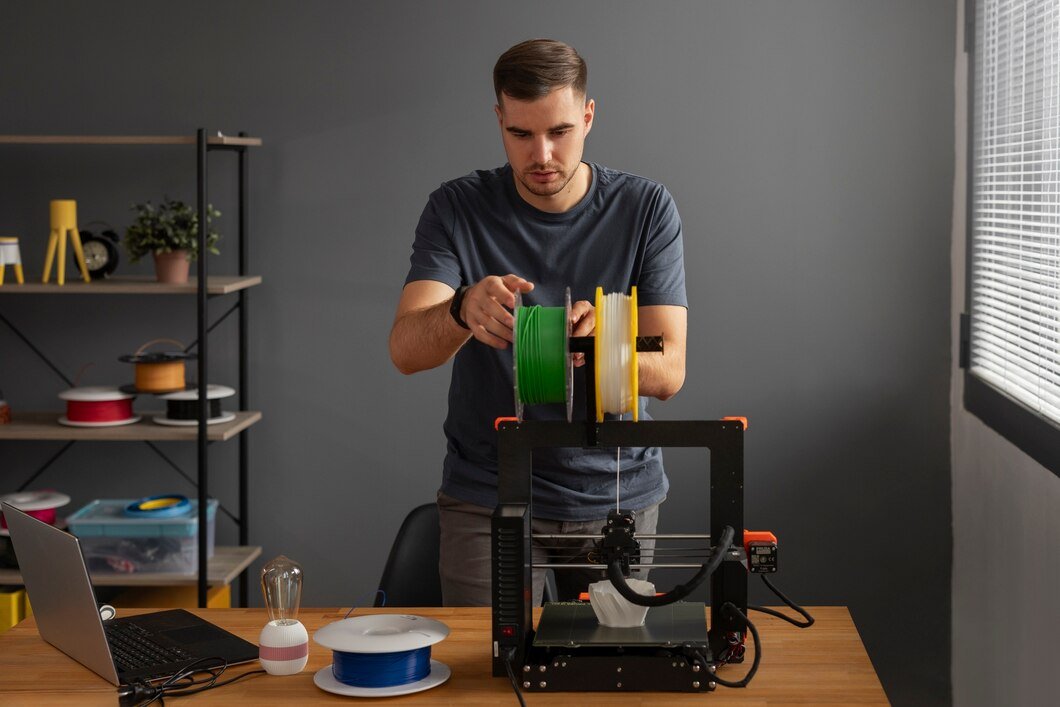Business
What Is Binder Jetting? An In-Depth Guide to This 3D Printing Technology

In the ever-evolving world of additive manufacturing, there are several techniques for creating three-dimensional objects from digital models. One of the most innovative and versatile methods is binder jetting. This technology has found applications across industries such as aerospace, automotive, medical, and even art. But what is binder jetting, and how does it work? In this blog post, we’ll explore the fundamentals of binder jetting, its benefits, applications, and how it compares to other 3D printing technologies.
Understanding Binder Jetting
Binder jetting is an additive manufacturing (AM) process that uses a binder material to bond particles of powdered material into solid objects. Unlike other 3D printing methods that melt or sinter material to build up a part, binder jetting uses a liquid binder to selectively glue powder particles together layer by layer, following a digital model.
Key Components of Binder Jetting
To break it down, there are a few key components involved in the binder jetting process:
- Powder Material: The base material in binder jetting is usually in powder form. It can be made of various substances, including metals, ceramics, sand, or plastics, depending on the desired end product. This powder is spread across a build platform in thin layers.
- Binder: A liquid binder is applied selectively to the powder by the printer’s print head, similar to how ink is deposited by an inkjet printer. The binder serves to fuse the powder particles together, forming solid structures.
- Print Head: The print head moves across the powder bed and deposits the binder according to the cross-sectional slice of the 3D model, layer by layer. The head typically uses piezoelectric or thermal jets to deposit precise amounts of binder.
- Build Platform: The platform is where the part is constructed. After each layer of powder is laid down, the build platform is lowered slightly, and a new layer of powder is spread over the surface before the binder is applied.
- Post-Processing: Once the object has been fully printed, the part is typically still embedded in loose powder. It needs to undergo post-processing steps, which may involve curing (for binding) or removing excess powder. In some cases, additional heat treatments or infiltration processes are needed to enhance the mechanical properties of the object.
The Binder Jetting Process
The binder jetting process can be broken down into the following steps:
- Preparation: The first step is preparing a 3D model of the object you wish to print. The model is sliced into thin cross-sectional layers, which will guide the print head in the subsequent steps.
- Powder Layering: The print bed is coated with a thin layer of powder. This powder can be metal, ceramic, or plastic, depending on the desired material properties of the final part.
- Binder Deposition: The print head moves across the powder bed, depositing the binder in the exact pattern that corresponds to the digital model. The binder bonds the powder particles together, solidifying the printed layer.
- Building the Object: The process repeats with subsequent layers of powder and binder being applied on top of each other, building up the object layer by layer. The print head continues to follow the contours of the model, creating a complex 3D structure.
- Post-Processing: After printing, the part is usually removed from the powder bed and cleaned. Depending on the material, additional steps such as sintering, infiltration with resins, or curing may be required to achieve the desired properties, such as strength and durability.
Advantages of Binder Jetting
Binder jetting offers a number of significant advantages over other 3D printing methods:
- Material Versatility: Binder jetting can be used with a wide range of materials, including metals, ceramics, sand, and composites. This allows manufacturers to create products that are tailored to specific applications and performance requirements.
- No Need for Heat: Unlike methods like selective laser sintering (SLS) or direct metal laser sintering (DMLS), binder jetting doesn’t require a heat source to fuse materials. This means it can process materials that are sensitive to high temperatures and allows for faster production times.
- Cost-Effective for Large Parts: Since binder jetting does not rely on lasers or expensive high-temperature equipment, it can be more affordable for large parts and prototypes. This makes it a compelling option for industries where cost is a critical factor.
- High-Resolution and Fine Detail: Binder jetting allows for high-resolution prints with fine details, making it ideal for applications that require intricate designs, like medical implants or small mechanical parts.
- Scalability: Binder jetting technology is scalable, making it suitable for both rapid prototyping and small to medium-scale production. The ability to print large volumes quickly makes it a versatile choice for manufacturers.
Applications of Binder Jetting
Binder jetting’s versatility and capabilities have led to its adoption across various industries. Some of the most notable applications include:
1. Aerospace and Automotive
In aerospace and automotive manufacturing, binder jetting is used to create lightweight, complex components that require high strength-to-weight ratios. Parts like brackets, fixtures, and even engine components can be printed using binder jetting. The ability to use metal powders, such as stainless steel or titanium, opens up new possibilities for the production of highly durable parts.
2. Metal Casting
Binder jetting is also used in the production of sand molds and cores for metal casting. In this process, a binder is applied to sand particles to form molds that can withstand the high temperatures of molten metal. This method reduces the time and cost traditionally associated with sand casting, while also enabling the creation of intricate mold designs.
3. Medical and Dental Applications
In the medical field, binder jetting is used to create custom prosthetics, implants, and surgical tools. Its ability to create highly detailed and complex shapes makes it well-suited for creating patient-specific solutions. Additionally, binder jetting can be used to print biocompatible materials that are essential in medical applications.
4. Consumer Goods
Binder jetting is used to produce everything from jewelry to figurines and other consumer products. Its capability to print in multiple materials, such as ceramics and plastics, allows for creative and customizable designs that meet both aesthetic and functional needs.
5. Research and Development
Binder jetting is an excellent tool for rapid prototyping in research and development environments. Engineers and designers can quickly produce functional prototypes to test and evaluate new concepts before investing in expensive tooling or manufacturing equipment.
Binder Jetting vs. Other 3D Printing Technologies
To understand the unique advantages of binder jetting, it’s helpful to compare it to other popular 3D printing methods, such as:
1. Fused Deposition Modeling (FDM)
FDM is one of the most commonly used 3D printing methods, where thermoplastic filament is melted and extruded to form parts. While FDM is generally more accessible and widely used for prototyping, it is limited in material variety and can struggle with creating parts that require high precision or fine details.
Binder jetting, on the other hand, can work with a broader range of materials and produces parts with higher resolution. Additionally, binder jetting doesn’t require a heated print head, allowing it to work with materials that are more heat-sensitive.
2. Selective Laser Sintering (SLS)
SLS is another powder-based 3D printing process where a laser is used to sinter (melt) the powder material layer by layer. While SLS can produce strong and durable parts, it requires high-powered lasers and significant heat, making it more expensive and time-consuming compared to binder jetting. Also, SLS is usually limited to certain material types like nylon, whereas binder jetting can print with a much wider range of materials, including metals and ceramics.
3. Direct Metal Laser Sintering (DMLS)
DMLS is a method for 3D printing metal parts using a laser to melt metal powder. While DMLS can produce very strong and detailed metal parts, the cost of the equipment and the need for post-processing can make it a less attractive option for some applications. Binder jetting, particularly with metal powders, offers a more cost-effective alternative for certain types of metal parts, although it may require additional post-processing steps like sintering.
Conclusion
What is binder jetting? It’s a highly versatile and cost-effective 3D printing technology that offers unique advantages in terms of material flexibility, speed, and production scale. Its ability to print complex parts with fine details makes it suitable for a wide range of industries, from aerospace to healthcare to consumer goods. As the technology continues to mature, we can expect binder jetting to play an increasingly important role in both prototyping and large-scale manufacturing, offering new opportunities for product innovation and efficiency.
Whether you’re a manufacturer looking to explore new materials or an engineer seeking rapid prototyping options, binder jetting offers a promising solution.
-

 Tech1 year ago
Tech1 year agoHow to Use a Temporary Number for WhatsApp
-

 Business2 years ago
Business2 years agoSepatuindonesia.com | Best Online Store in Indonesia
-

 Social Media1 year ago
Social Media1 year agoThe Best Methods to Download TikTok Videos Using SnapTik
-

 Technology1 year ago
Technology1 year agoTop High Paying Affiliate Programs
-

 Tech10 months ago
Tech10 months agoUnderstanding thejavasea.me Leaks Aio-TLP: A Comprehensive Guide
-

 FOOD12 months ago
FOOD12 months agoHow to Identify Pure Desi Ghee? Ultimate Guidelines for Purchasing Authentic Ghee Online
-

 Instagram3 years ago
Instagram3 years agoFree Instagram Auto Follower Without Login
-

 Instagram3 years ago
Instagram3 years agoFree Instagram Follower Without Login



















